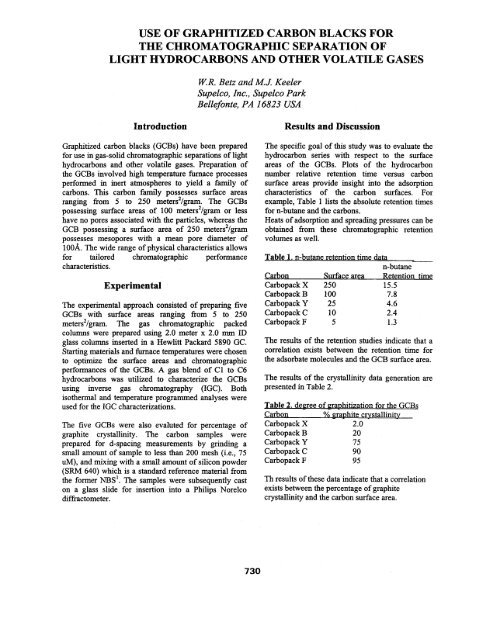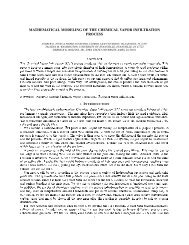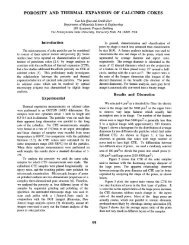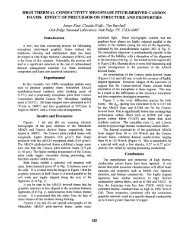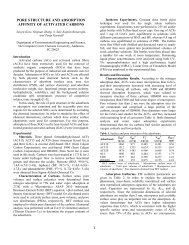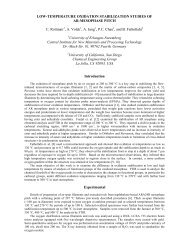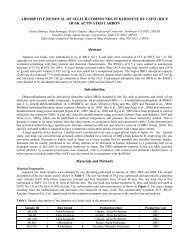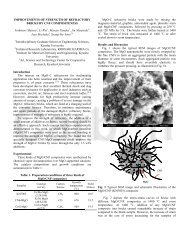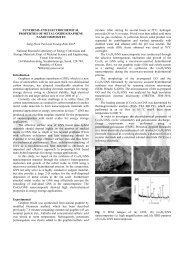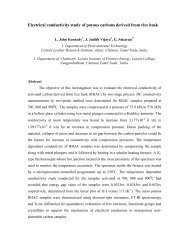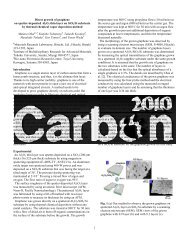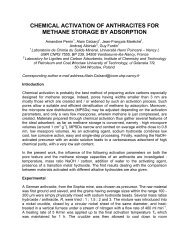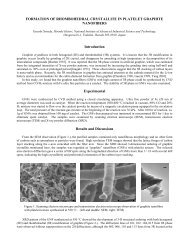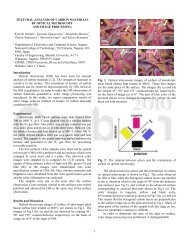1999: Use of Graphitized Carbon Blacks for the Chromatographic ...
1999: Use of Graphitized Carbon Blacks for the Chromatographic ...
1999: Use of Graphitized Carbon Blacks for the Chromatographic ...
Create successful ePaper yourself
Turn your PDF publications into a flip-book with our unique Google optimized e-Paper software.
USE OF GRAPHITIZED CARBON BLACKS FOR<br />
THE CHROMATOGRAPHIC SEPARATION OF<br />
LIGHT HYDROCARBONS AND OTHER VOLATILE GASES<br />
W.R. Betz and M.J. Keeler<br />
Supelco, Inc., Supelco Park<br />
Bellefonte, PA 16823 USA<br />
Introduction Results and Discussion<br />
<strong>Graphitized</strong> carbon blacks (GCBs) have been prepared<br />
<strong>for</strong> use in gas-solid chromatographic separations <strong>of</strong> light<br />
hydrocarbons and o<strong>the</strong>r volatile gases. Preparation <strong>of</strong><br />
<strong>the</strong> GCBs involved high temperature furnace processes<br />
per<strong>for</strong>med in inert atmospheres to yield a family <strong>of</strong><br />
carbons. This carbon family possesses surface areas<br />
ranging from 5 to 250 metersZ/gram. The GCBs<br />
possessing surface areas <strong>of</strong> 100 metersZ/gram or less<br />
have no pores associated with <strong>the</strong> particles, whereas <strong>the</strong><br />
GCB possessing a surface area <strong>of</strong> 250 metersZ/gram<br />
possesses mesopores with a mean pore diameter <strong>of</strong><br />
100A. The wide range <strong>of</strong> physical characteristics allows<br />
<strong>for</strong> tailored chromatographic per<strong>for</strong>mance<br />
characteristics.<br />
Experimental<br />
The experimental approach consisted <strong>of</strong> preparing five<br />
GCBs with surface areas ranging from 5 to 250<br />
meters2/gram. The gas chromatographic packed<br />
columns were prepared using 2.0 meter x 2.0 mm ID<br />
glass columns inserted in a Hewlitt Packard 5890 GC.<br />
Starting materials and furnace temperatures were chosen<br />
to optimize <strong>the</strong> surface areas and chromatographic<br />
per<strong>for</strong>mances <strong>of</strong> <strong>the</strong> GCBs. A gas blend <strong>of</strong> C1 to C6<br />
hydrocarbons was utilized to characterize <strong>the</strong> GCBs<br />
using inverse gas chromatography (IGC). Both<br />
iso<strong>the</strong>rmal and temperature programmed analyses were<br />
used <strong>for</strong> <strong>the</strong> IGC characterizations.<br />
The five GCBs were also evaluted <strong>for</strong> percentage <strong>of</strong><br />
graphite crystallinity. The carbon samples were<br />
prepared <strong>for</strong> d-spacing measurements by grinding a<br />
small amount <strong>of</strong> sample to less than 200 mesh (i.e., 75<br />
uM), and mixing with a small amount <strong>of</strong> silicon powder<br />
(SRM 640) which is a standard reference material from<br />
<strong>the</strong> <strong>for</strong>mer NBS 1. The samples were subsequently cast<br />
on a glass slide <strong>for</strong> insertion into a Philips Norelco<br />
diffractometer.<br />
730<br />
The specific goal <strong>of</strong> this study was to evaluate <strong>the</strong><br />
hydrocarbon series with respect to <strong>the</strong> surface<br />
areas <strong>of</strong> <strong>the</strong> GCBs. Plots <strong>of</strong> <strong>the</strong> hydrocarbon<br />
number relative retention time versus carbon<br />
surface areas provide insight into <strong>the</strong> adsorption<br />
characteristics <strong>of</strong> <strong>the</strong> carbon surfaces. For<br />
example, Table 1 lists <strong>the</strong> absolute retention times<br />
<strong>for</strong> n-butane and <strong>the</strong> carbons.<br />
Heats <strong>of</strong> adsorption and spreading pressures can be<br />
obtained from <strong>the</strong>se chromatographic retention<br />
volumes as well.<br />
Table 1. n-butane retention time data<br />
n-butane<br />
<strong>Carbon</strong> Surface area Retention time<br />
Carbopack X 250 15.5<br />
Carbopack B 100 7.8<br />
Carbopack Y 25 4.6<br />
Carbopack C 10 2.4<br />
Carbopack F 5 1.3<br />
The results <strong>of</strong> <strong>the</strong> retention studies indicate that a<br />
correlation exists between <strong>the</strong> retention time <strong>for</strong><br />
<strong>the</strong> adsorbate molecules and <strong>the</strong> GCB surface area.<br />
The results <strong>of</strong> <strong>the</strong> crystallinity data generation are<br />
presented in Table 2.<br />
Table 2. degree <strong>of</strong> graphitization <strong>for</strong> <strong>the</strong> GCBs<br />
<strong>Carbon</strong> % graphite crystallinity<br />
Carbopack X 2.0<br />
Carbopack B 20<br />
Carbopack Y 75<br />
Carbopack C 90<br />
Carbopack F 95<br />
Th results <strong>of</strong> <strong>the</strong>se data indicate that a correlation<br />
exists between <strong>the</strong> percentage <strong>of</strong> graphite<br />
crystallinity and <strong>the</strong> carbon surface area.
Conclusion<br />
A series <strong>of</strong> five graphitized carbon blacks has been<br />
generated, and chromatographically evaluated using a<br />
C1 to C6 hydrocarbons series. Crystallinity data have<br />
also been generated. The data indicate that a correlation<br />
exist between <strong>the</strong> carbon surface areas and <strong>the</strong><br />
chromatographic retention data, and that a correlation<br />
exists between <strong>the</strong> carbon surface areas and <strong>the</strong> carbon<br />
degree <strong>of</strong> graphitization.<br />
References<br />
1. Aune, F., Brockner, W., and Oye, H.A., <strong>Carbon</strong>.<br />
1992, 30, 1001.<br />
731


